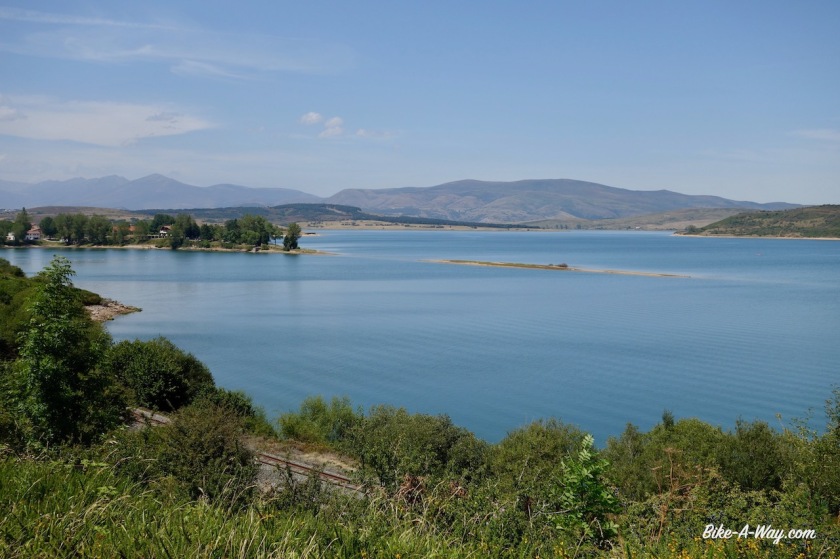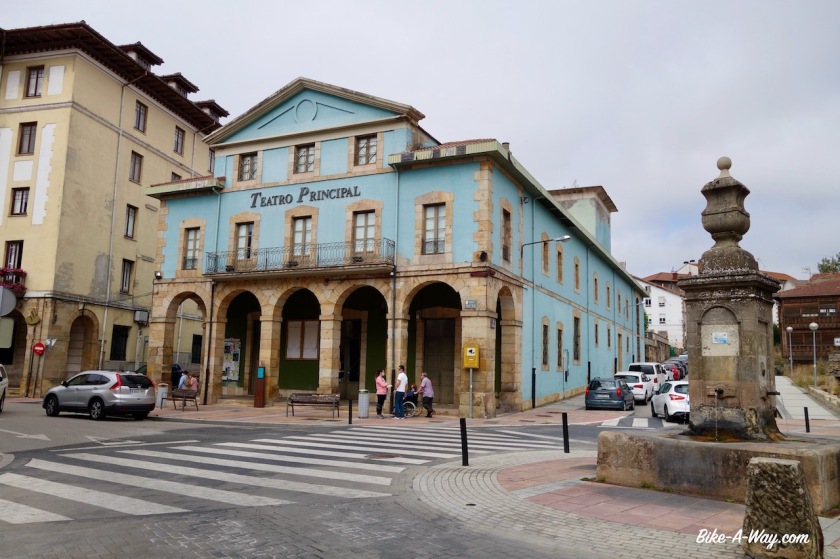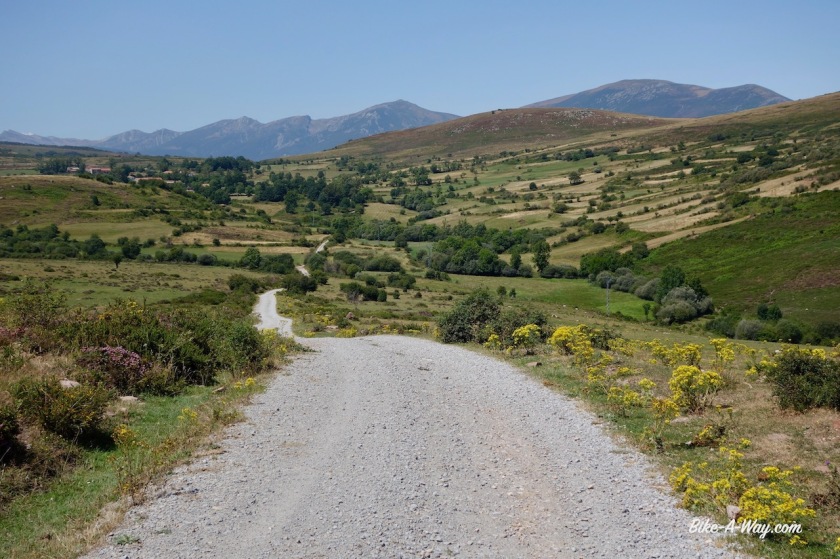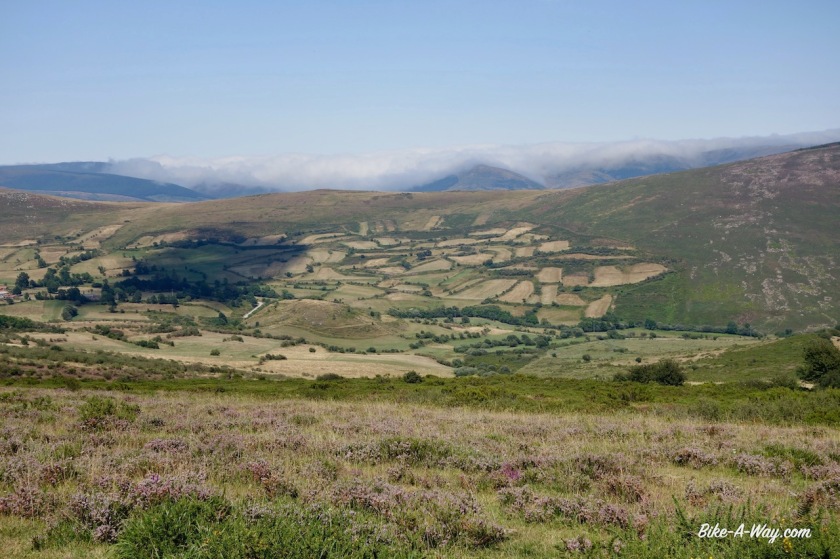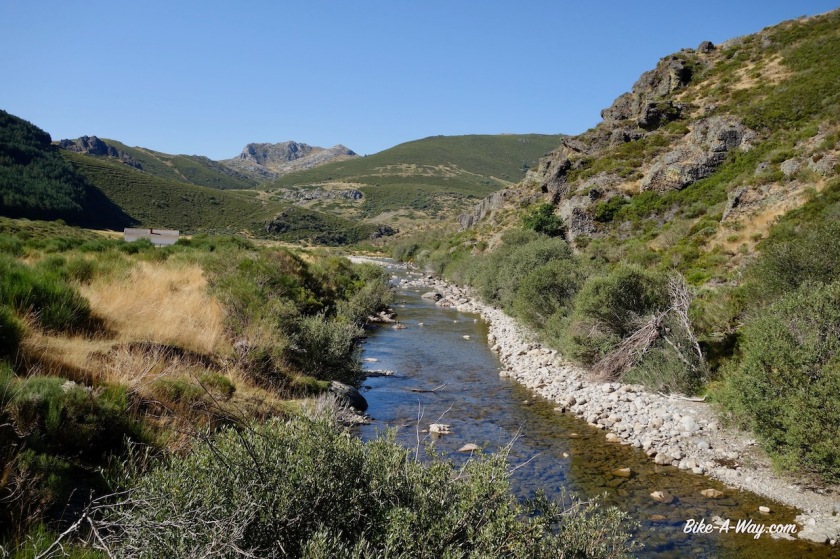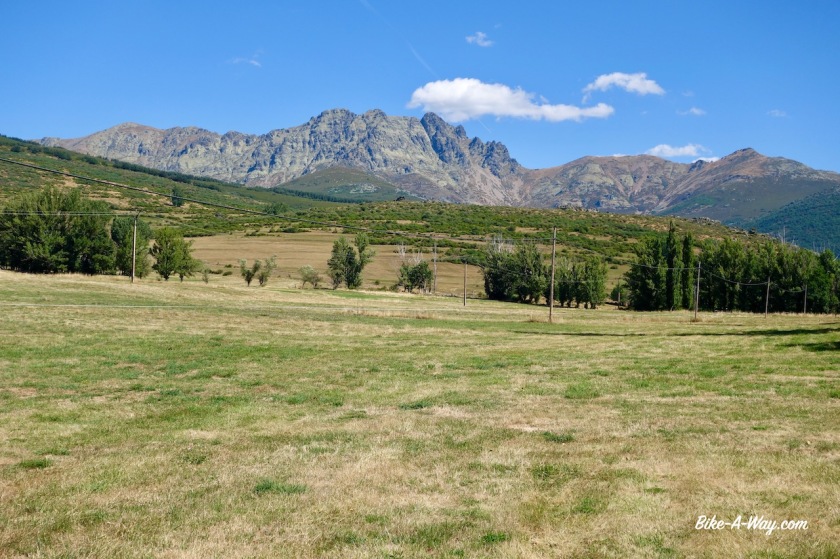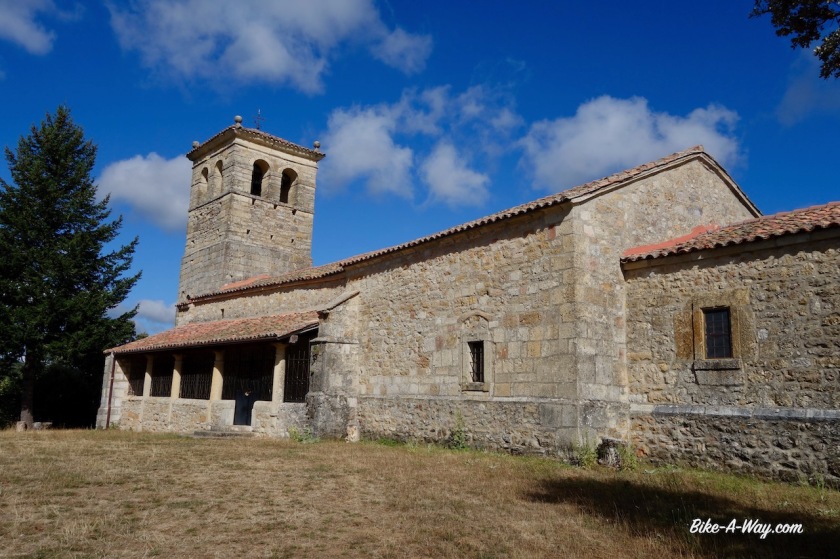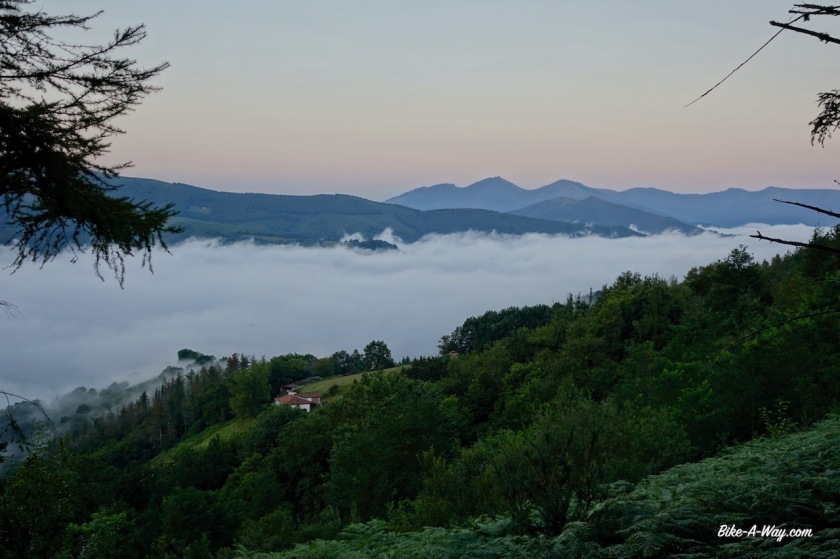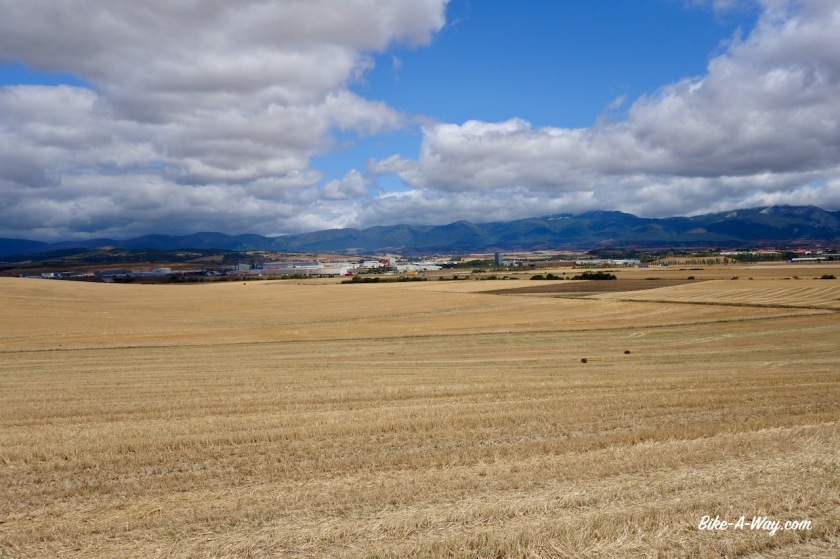Route: Boñar – Pto. Vegarada – La Pola – Pto. de la Cubilla – Saliencia – Villablino – Vega de Espinareda – Ponferrada

With food in my bags for three days, I now had to decide what route to take. The weather was still fine today, but the forecast for the next five / six days was pretty terrible. I pondered it over for a while on a bench near the town square in Bonar. The initial route would lead my all the way over the Cordillera Cantabrica, back to its northern slopes, than down, before remounting, to the southern side, quite a lot via unpaved tracks.
Or I could follow tiny roads LE-321, LE-3621 & LE-3505, going right through the mountains, but staying on the south side.
The latter option, I rode already in 2005.
After forty five minutes of thinking, I decided on the second option. There was more rain predicted on the northern side, colder temperatures, and all that on dirt and gravel tracks…. that’s good in the sun, but it could be miserable in the wrong conditions.
Having ridden this route already, I remembered it was “nice”, but I didn’t recall it specifically. And what a good choice I made. The ride through the canyon of the River Curueno is simply super, super impressive. Incredible how this tiny river has cut out such a deep canyon in the barren mountains.





At the left turn towards Valdeteja, I leave the Rio Curueno. The road starts climbing a little more. I was thinking “where does this road lead to, if I were to go straight ?”.
Of course ! It would lead me Valdelugueros, and then I would be back on the route I planned, going north. This means I made good progress already.
“Should I do it ?”
I kept riding the other direction, the paved option, thinking if I kept doubting long enough, the moment to turn around would have passed.
It’s a nice enough road I’m on. Wait, I just ride a little further up, to that bend in the road, and then I decide. Let’s take a picture… I seemed to have turned the bike around already, and back down I went towards the Rio Curueno and.. going north…
The road climbs only very slowly and once you’re in Tolibia de Abajo, you’re out of the canyon. (If people would ever ride that paved option, the most spectacular part is before the junction towards Valdeteja, so you’ve seen the best).


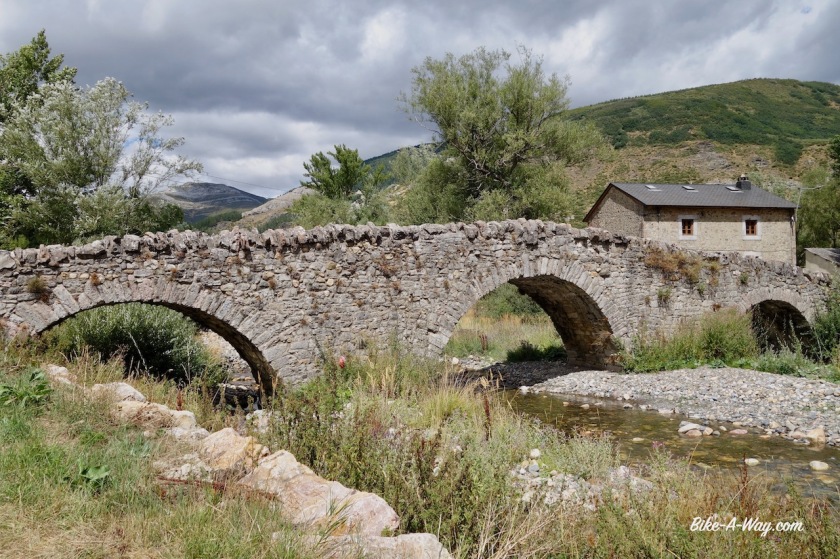
After Valdelugueros the road starts to climb a little more, but still nothing terrible. Left and right of me, all mountain tops above two thousand meter; Pico de Fuentes, Pico del Oso, Pico Nogales, ….
The top lays at 1.563 meter, the ‘Puerto Vegarada’. As so often, the top is also a border, this time between Castilla y Leon and Asturias.



In front of me lays a nice gravel track and the good news is, I will go down from 1563 meter to 200 meter in one go.
The bad news is, I then have to climb back up to almost 1.700 meter, also in one go.
The downhill, smooth at first, soon goos steep, steep into the valley. 12%, 14%, 16%…. 20%. With three days worth of food and 5,5 liter of water (ready to camp if I see a spot), it surely is stretching the limits of my v-brakes on these track full of loose gravel.
I find a spot next to the Rio Aller in its early stages.




The downhill remains steep until I hit the asphalt.
I surely hope that climb back over the Cordillera will be easier.
The Rio Aller soon becomes wider. It starts raining, and looking up at the sky, it won’t stop anytime soon. Time for a hotel for two nights and give the legs some rest.


I now have left the valley of the Rio Aller, and riding upstream in the valley of the Rio Lena. A busy valley with a major highway, a provincial road, a railways and villages and towns all squeezed into that narrow space. Still, I found good options to go almost car free through it.
I am ready for the ‘grand finale’, back over the Cordillera Cantabrica, north to south, with some serious climbs ahead of me.
I start with a mountain, nicknamed ‘The Gallibier off Asturias’; Puerto de La Cubilla to Alto ‘L Palo (1.690 m) / The Vuelta a Espagne passed here in 2019 (stage 16). Jacob Fuglsang won the stage, and also two Belgians were in the top 10, Thomas De Gendt and Philippe Gilbert. Tadej Pogacar did the 17 km long climb at the fastest average speed, 25,3 km/hr ! You can see a resume of that stage here.
Today, my time was a little bit slower as Pogacar’s last year, but there was nobody in front of me when I came to the top !



As if the climb wasn’t long enough, I was fighting a very fierce headwind.But what a beautiful climb it is, and the gradients are much, much more doable as that downhill I had a couple of days ago.
The region Asturias is famous for producing milk. In all Spanish supermarkets you’ll find the Asturias milk. And I think all the cows producing it, are on this mountain. So, not good for camping, but I haven’t seen a flat piece of land anywhere anyway.
Working my way up, I keep some beautiful tops in view, Siega L’Aba (2.131 m), La Mesa (1915 m), Penon de Vachalampo (1800 m), Quentu Las Planas (1856 m), La Tesa (1900 m).










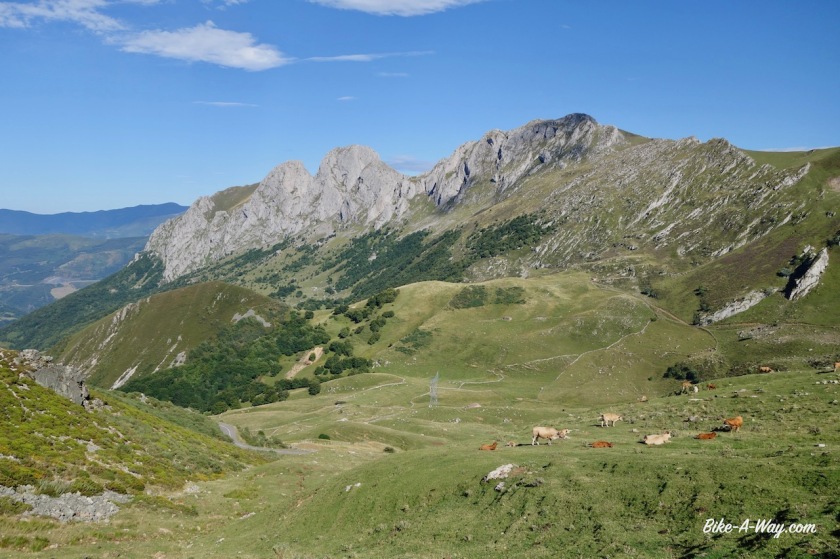



At the top, I’m leaving the Asturias region and enter Castilla y Leon again.
The wind at the top was very violent and almost knocked one over.
After Casa Miers (closed), I’m back on dirt for the downhill through the ‘Barranco de la Alcantarilla’ to the village San Emiliano.

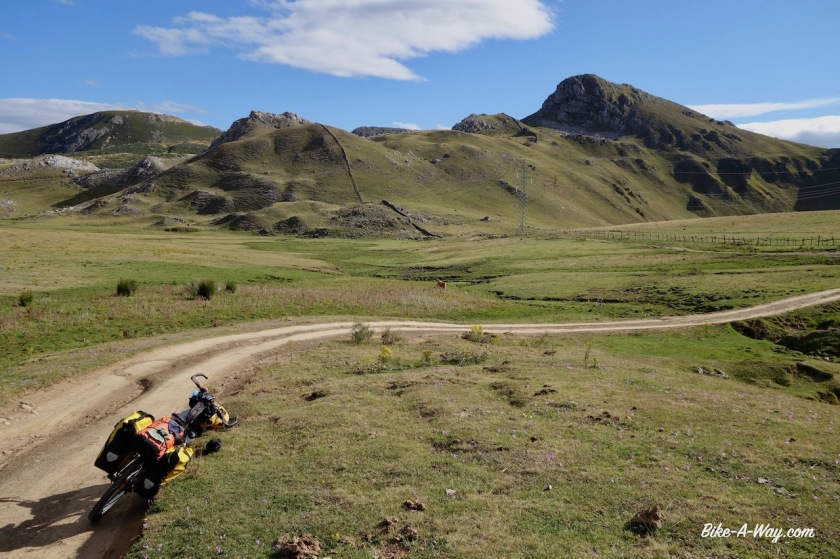


After this village, I have a smooth climb over a paved road. If I would keep following this road, I’d go to the Puerta Ventana, but I take the small side road towards Torrestio. After the village the road becomes a stony track, always steeper and steeper, until I’m up the Alto de Farrapona (1708 m).






From the pass, a little, stony track goes left towards the ‘Lagos Saliencia’. I ride my bike towards the first lake, ‘Lago Cueva’. I intended to visit the first lake only, but it’s so beautiful that I lock my bike and start hiking up to Lago Cerveriz and on to Lagos Calabazosa o Negro. The dark lakes with the sharp mountain peaks all around it are spectacular and worth the effort. I see a small track I can follow to make the loop complete around the back of Lagos La Cueva.






Camping is not allowed here so I ride down, into the nature park Somiedo, where camping isn’t allowed either.
The park is famous for having a large population of wolves and free roaming bears and is said to be one of Spain’s roughest natural areas. The highest peak is Pico del Cornón (2194 m)
I went to the camp site in La Pola. It’s behind the hotel and belongs to them. Before going to the reception, I went to take a look. Instant unhappiness. I don’t want to be here. It’s horror. People, cars, caravans, campervans,… all packed on top of each other on the small field. Even if they pay me, I don’t want to be here.
I rolled back down towards a field I saw just before the confluence of the Rio Somiedo and Rio Saliencia. The tent is pitched next to the river. A lot of grass in the field. If I’m lucky, I might see a bear this evening or tomorrow morning.
But alles, no such luck. Cold it was. Terribly cold, although it’s one of the lowest places I slept recently. Must be ‘inversion’, I remember from school, when it’s warmer high up as down in the valley.



After Pola la Somiedo I have another three mountain passes in front of me. Before the first pass, I first take a side road to the viewpoint ‘Mirador Principe de Asturias’ It’s on a little steep climb into La Peral village, but do make the effort if you come here. It really is worth the view !







Than, over Puerto de Somiedo (1.485 m). Here I leave Asturias and enter Castilla y Leon again. The downhill is super smooth, low percentages.

I eventually end up again at the busy road CL-626.
Never, ever think it’s a good idea to have a bicycle holiday and follow this road along the Cordillera Cantabrica. It carries way too much traffic.
I think I could have left the busy road already in Villaseca de Laciana and go on the via verde, but I only saw its existence just before Villablino.
Also west of Vilablino is a via verde over an old railway line to the village Caboalles de Arriba. This used to be a mining area, that’s why they had the railway.
Back over the next pass, Puerto de Cerredo (1.359 m) via which I enter Asturias again.
Downhill to the ugly mining town Zarréu where I turn left on a so-called private mining road (built by or for them). it is a very wide road and doesn’t even have an official road number, but the people down in Zarréu assured me I could take it.
Climbing again. On the top, Puerto Valdeprado (+/- 1.350 m), I again enter Castilla y Leon.

It’s hard to find a place to camp, which is annoying when you’ve climbed three passes and daylight is fading, but eventually I’m lucky to find a splendid place.
Resuming the decent next morning, also on this side of the mountain, there are regularly signs that it’s a private mining road, but I see a few other cars and nobody is bothering me cycling here. The power plant I pass a little later seems permanently closed, so I really think it’s ok to use this road. Slowly I’m leaving the Cordillera Cantabrica behind, riding down along the Rio Cua. Some steep parts back up again too, but mostly down for me. I’m in a bit of a hurry. It’s Sunday and I need a bakery before siesta time. I find it eventually in Fabero.
In the next town, Vega de Espinareda, I could go straight south towards Ponferrada, but that would be a major road, so I searched for a better alternative. I go east towards Berlanga Del Bierzo on a quieter road, on to Tombrio de Arriba and to Torina, where after a short stretch and the wider (but not busy) LE-463, I exit the road to take a small, unused road of which all the asphalt is crumbling, along the Embalse de Barcena, the big reservoir in the Rio Sil. Nobody else here and I have brilliant views to the lake and to the old railway line with its bridges and tunnels.



Just as I’m leaving the borders of the lake, I see yellow signs again, and it appears I’m back on the lesser used Santiago route ‘Camino Olvidado’ (remember, near the town of Bonar, I was already sharing this route for a while).
On my way into Ponferrada I pass a big windmill factory. They were just loading the wings on trucks. Unreal how large they are. From the ground, you could never see the edges of the wings are like a saw.
Next report, I’ll be leaving Ponferrada behind and head towards Portugal.























